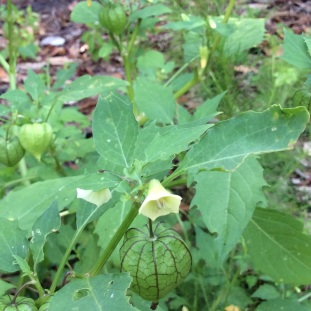
Britton, N.L., and A. Brown. 1913. An illustrated flora of the northern United States, Canada and the British Possessions. 3 vols. Charles Scribner’s Sons, New York. Vol. 3: 161. Provided by Kentucky Native Plant Society. Scanned by Omnitek Inc.
Where Commonly Found: Dry woods and clearings, CT, MA, ME, NH, NY, RI, VT.
How to Identify:
(For unfamiliar words: Wikipedia Glossary of Botanical Terms).
Go Botany Key for Physalis heterophylla.
Illinois Wildflower’s description of Physallis heterophylla. Click on more images.
WARNING: UNRIPE BERRIES AND LEAVES are highly toxic, may be fatal if eaten. Ripe fruits are supposedly edible…caution!!
Flower Color: Light yellow/green with large brown nectar guides.
Flower Type: Radial, 5 petals. Nodding single flowers, 1/2″ – 1″ wide, funnel-like, hanging from the leaf axils.
Flower Time: July to September
Leaf Arrangement: Alternate, Stems are branching, and have sticky-glandular hairs, hence the “clammy” name, mixed with longer, nonglandular hairs.
Leaf Type: Simple, 1″ – 3″ long, oval or triangular, with irregular teeth, though sometimes entire and rather pubescent surface. Petioles are u-shaded in cross-section, pubescent on the lower, rounded site while the flat upper part is mostly glabrous. Older leaves are less pubescent.
Height: 1′-3′
Seed Collection: Ripe fruit, yellow, has papery veined husk, (closely related to a tomatillo), 1/2″ wide, hairy and rounded oblong. Let fruit become overripe before harvesting. Remove the papery husk and let the fruit dry. Then remove the fleshy coating to retrieve the closely-packed, flat, round seeds.
Attracts: Bees, birds.
Use: Naturalizing, some may consider nearly invasive, spreading with lateral roots that are 2″ – 4″ below the soil surface and may run 4′ or more.
Light: Full sun to part shade
Hardiness Zone: 7 – 10 USDA Zone Map
Soils: Dry
Notes: Not a particularly showy plant, but certainly an interesting native, worth considering in a place where a massing would be beneficial. Not really hardy in northern parts of the New England/New York region.
Native to most of US east of the Rocky Mountains: Biota of North America Program (BONAP) – North American Plant Atlas (NAPA).
Requested by Edgewood Nursery.


You must be logged in to post a comment.